It’s the stuff of childhood. A boy stands in the green grass, sun on his face, dust in his eyes, and awaits that pitch to come screaming down the line. He’ll grip the bat, aligning it with anticipation and hope to get the big knock that will give his team the lead. It’s the same scene the world over, though we’re not talking baseball. This is cricket, and these are the blokes of summer.
Cricket in Memphis means weekend days filled with intense play for the nearly 250 men of the eight Memphis teams, part of the Ark-Tenn Cricket League governed by the U.S.A. Cricket Association, which is, in turn, overseen by the International Cricket Council.
It’s a Saturday morning in Bartlett, and the early September sun is already scorching the neatly clipped grass. The players for the Bartlett Youth Cricket Club (BYCC) and the Memphis Cricket Club (MCC) are prepared for the heat with oversized, floppy hats providing shade and faces slathered in sunscreen. Nearby, tennis matches are in full swing as a farmers market is set up in the parking lot. A children’s football game gets under way, and the aroma of a family reunion cookout wafts through the air. Players lounge in the shade of a portable canopy with Gatorade, bottled water, and Marlboros to trade tips and strategies in their native languages, as unfamiliar to the casual observer as a baseball catcher’s hand signals.
Sal Samana is an officeholder of the BYCC, whose members, many hailing from Pakistan, as he does, wear the green of that country’s national team. Samana makes a point to mention the city of Bartlett, saying he “appreciates the opportunity for a place to play the game.” The city, when contacted by the league, was willing to set aside the field and create a pitch for the teams to play on. Another field was created by the city of Memphis behind the Hickory Hill Community Center on Ridgeway at Winchester.
Cricket is somewhat new to Memphis, but elsewhere around the globe, there is evidence of cricket being played as early as the 16th century, sometime after Ferdinand Magellan circumnavigated the earth but before the Gregorian calendar was adopted. Its popularity was later spread throughout the British Commonwealth of Nations into every outpost under royal rule. Today, it is played by millions in 106 countries, second in world popularity only to soccer.
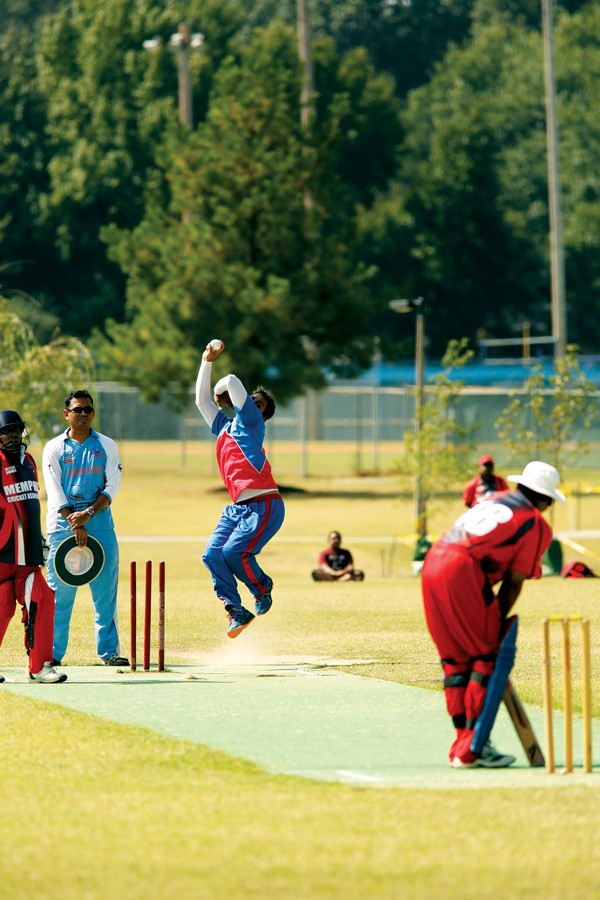 Justin Fox Burks
Justin Fox Burks
Cricket had its heyday in America in the early 1700s, when it was known as America’s pastime. Really. A match between the United States and Canada in the 1840s was attended by 10,000 fans and is regarded as the first international sporting event. It was around this time that America’s current national pastime — baseball — was invented, and its allure would soon surpass that of cricket.
Organized cricket came to Memphis in 2006. It’s a game still on the fringes in this country, yet there it is, every weekend between March and November, on the fringes of Freeman Park on Bartlett Boulevard just outside the Memphis city limits.
There are several incarnations of the game, the most commonly referred to being Test cricket, where a single match can take up to five days to play. In Memphis, you’ll find the much shorter game of Twenty20 played. And because it might make it easier for Americans raised on a steady diet of ESPN to understand, let’s get to the similarities between cricket and baseball: Twenty20 cricket is played in innings (only two); there are batters (two as well, on the field at the same time) and a pitcher (he’s called the “bowler”). There you have it. There are no mitts or time limits, the batsmen are dressed like catchers, and a ball stays in play for 360 degrees around the batsman.
Despite the worldwide popularity of cricket, devoted spectators in Freeman Park are scarce. Dog walkers, parents following children on bikes, and joggers stop to watch the action from time to time.
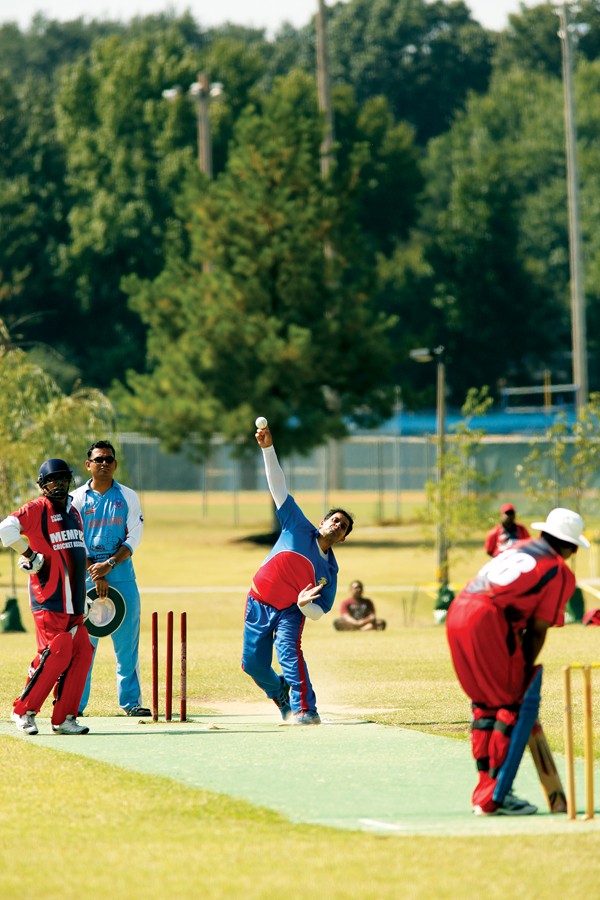 Justin Fox Burks
Justin Fox Burks
Amer Aziz of the BYCC is quick to ask a curious visitor if he has any questions and explains the rules. His attention, however, stays with his team, and he stomps away to stalk the sidelines like a coach and encourage his team on the field. “Keep the pressure on!” he shouts.
Ashish Vaidya, 33, is originally from Bombay, India, and grew up playing the sport, as many of his countrymen do. He moved here in 2005 and manages a nearby Comfort Inn. He points to the orange cones around the perimeter and explains that a cricket field is an oval with boundaries placed at 200 feet from the pitch, a 22-foot-long strip of concrete with outdoor carpet stretched along the top. At either end of the pitch are wickets — three upright “stumps” with pieces of wood known as “bails” balanced across the tops. The safety zone in front of the wickets is called the “popping crease,” and this is where the batsmen stand and inside of which they are safe while running.
Points are scored after a ball is hit and the two batsmen — the one batting is “on strike,” the other a “runner” — run to their opposite wickets. As they pass each other, one run is tallied. The batsmen may run back and forth as many times as possible before the ball makes it back to put down the wicket, resulting in an out. If a batted ball flies to within the 200-foot boundary and then rolls out, it’s four points; if it crosses over that boundary in the air, six are counted.
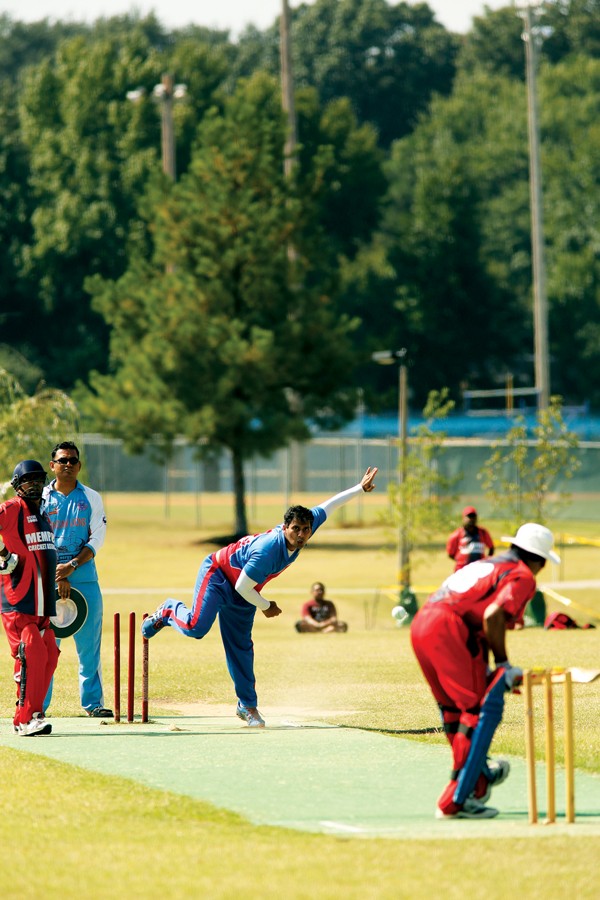 Justin Fox Burks
Justin Fox Burks
A batsman is out if the batted ball is caught on the fly or if the ball is pitched and hits the wicket without being batted and the bails are knocked from the top.
The duration of a Twenty20 inning is 10 outs or 20 overs, whichever comes first. An “over” is six legal balls pitched in succession. The pitch itself is a spectacle, the bowler uncoiling his body with a half-dozen leaping steps, his arms windmilling until the ball is released at the arc’s apex. The ball, heavier than a baseball, bounces on the pitch before screaming in at knee-height. The batsman hopes to alter its trajectory with a flat bat made of English willow.
It’s a slower game than baseball, if that’s possible. George Bernard Shaw said, “Baseball has the great advantage over cricket of being sooner ended.” But there is no denying the excitement when a big run is scored. The batting team is uproarious as their man makes contact and the ball sails out of bounds for a six. Aziz is on his feet, trilling the “d” and “r” together as he shouts, “Good run!”
Despite such bursts of action and enthusiasm, an hour into this Saturday match and there are only eight overs and two outs. The score is 67-0.
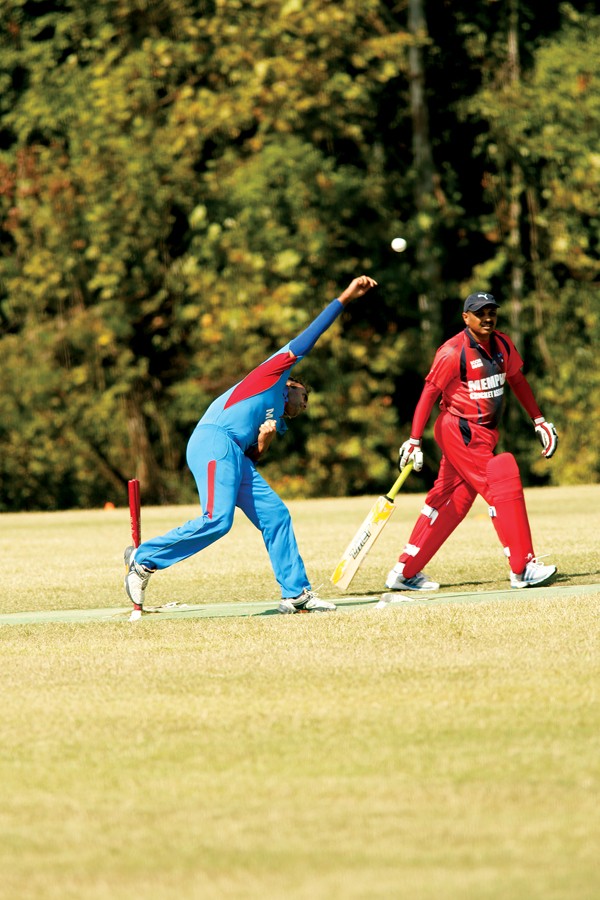 Justin Fox Burks
Justin Fox Burks
Saravan Chaturvedi, originally from Hyderabad, India, is a programmer for MLGW and member of BYCC. His play predates the local organized clubs by nearly 10 years. When he first came to Memphis in 1997 for graduate school at the University of Memphis, there was no Ark-Tenn Cricket League. Instead, he and a ragtag group of fellow students — “usually hungover from late Friday nights,” he said — and a few professors would gather in a parking lot on Southern Avenue, alongside the tennis courts at the school, for a Saturday afternoon match. Dividing themselves into two teams made up largely of engineering students, Chaturvedi said, they would “take a tennis ball and tape it with duct tape so it would last longer and the bounce would be similar to that of a cricket ball.”
It was a way to stay connected to their culture and foster camaraderie among those far from home. And it was a little risky; the asphalt of the lot hindered any diving catches to make an out. In professional cricket, the ball might be bowled at more than 90 mph. Though it’s not quite that fast for these weekenders, they remain vigilant, as balls are caught barehanded by the 11 men in the field. With the ball in play anywhere, there is always the possibility for injury. Before the game on this September Saturday, a cricketer was taken to the emergency room for five stitches in the face after being hit by a ball deflected off his bat.
The Memphis players grew up playing their version of sandlot cricket and following their favorite professional teams. The majority are from India and Pakistan, though Vaidya said he’s played with folks from Australia, South Africa, and England. Ali Iftikhar of the BYCC grew up in Lahore, Pakistan, and is a devoted fan of the Pakistan national team. (The team is currently ranked 6th in Test match by the International Cricket Council.) Iftikhar came to the United States in 1992, eventually making his way to Memphis to manage Shoe Time stores. He gravitated to the recreational sport, he said, because “we don’t go out clubbing or to bars or stuff like that, so, for us, we needed something like this.”
Samana, a car salesman, was captain of his high school cricket team and played in college. He’s lived and played in Pennsylvania and Chicago, places with much more participation and more than 40 teams. He said cricket keeps the young men out of trouble: “I’ve had mothers tell me, ‘My kid was going to clubs. Now he worries he has to get up and play.'”
Iftikhar lived for a time in Miami and is a big fan of the Dolphins and Heat. He said the Michael Jordan or Kobe Bryant of Pakistani cricket is Imran Khan, a former cricketer and popular politician. “A lot of youngsters support him,” Iftikhar said. “He has a lot of seats in the [Pakistan Tehreek-e-Insaf] party, and other countries support him too.”
“There’s still that pull and identity that you feel,” said Chaturvedi, describing his devotion to the India national team (ranked third by the ICC). As a fan, he maintains that the best current batsman is India’s Sachin Tendulkar. It is universally accepted, though, that the best Test cricket batsman was Sir Donald Bradman of Australia, who played from 1928 to 1948.
Another Australian, Darren Beazley, is the new CEO of the U.S.A. Cricket Association (USACA). Though the popularity of the sport in America has waned since that match with Canada in the 19th century, Beazley is intent on revitalizing it. There are now 32,000 cricket players in 54 leagues around the U.S.
“It’s a niche sport,” Beazley said by phone from Indianapolis, where he was working with that city on hosting the national championships in August 2014. “Some leagues are very well organized, and they run quite big leagues. Ark-Tenn is an example of that. Others need a bit more help. We really feel that, by opening it up and making it broader and getting more boys and girls from all walks of life involved, we can actually start to get more people aware of cricket and understanding that cricket’s not a five-day game. The form that we’re promoting is Twenty20, which is three hours, the same length as a baseball game.”
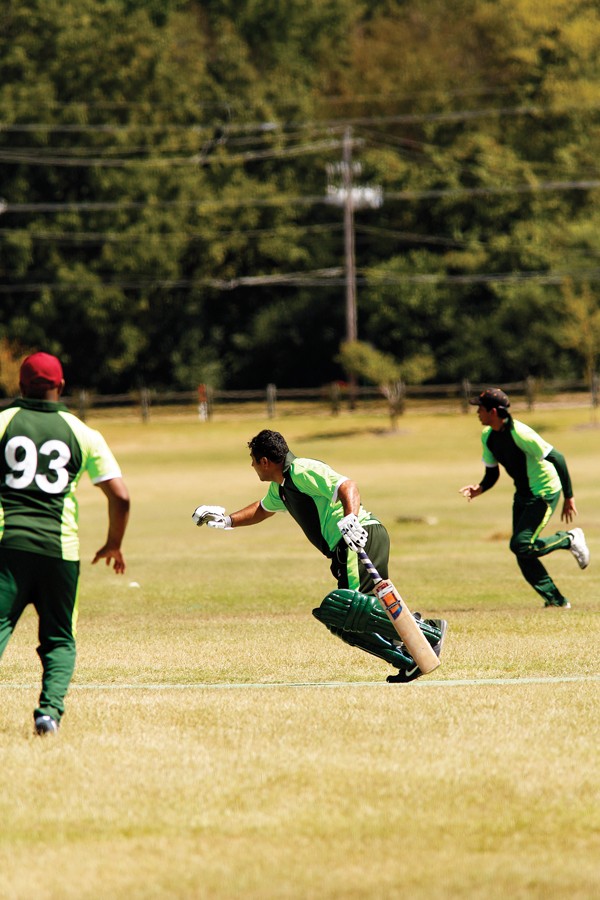 Justin Fox Burks
Justin Fox Burks
Beazley has traveled the country since arriving eight months ago in an effort to broaden his sport’s appeal. He visited Memphis two months ago and was impressed with the city and the cricket community. As coincidence would have it, Memphis is also the home of Beazley’s mother-in-law.
The Cricket World Cup is held every four years, most recently in 2011 in Mumbai and won by India. A pivotal moment in world cricket was 1983, when India upset the long-reigning team from the West Indies.
“The game of cricket changed in 1983, with India winning, and so the center of the political power of cricket gradually moved from England to India,” said Chaturvedi, adding that its governing organization, the Board of Control for Cricket in India, has become the most powerful board in the world. “India went crazy for cricket after 1983.”
Beazley and the USACA have impressive goals for cricket in this country, with a three-year plan aimed at increasing the number of players to 50,000, engaging media outlets such as ESPN to air championship series, and increasing and improving regional facilities.
If the enthusiasm on the pitches in Bartlett and Hickory Hill is any indication, the fever for the sport runs high. With the community of immigrants expanding as more and more international companies look to Memphis, the fervor to play should increase. A sport on the fringe may even begin to hold its own in the land of SEC football and Grit ‘n Grind.
Two hours into the September Saturday match, the farmers market has called it a day, and the football game has ended. With one inning in the books, the MCC ends its time at bat and the BYCC comes on strong. Though they are determined, they’re unable to pull out a win, losing 148-112.
As with any sport, there is a winner and there is a loser, but for these men, there is also sportsmanship, a welcome cultural familiarity, and an attachment to a sporting tradition as old as the calendar and as traveled as Magellan.
It’s fall, y’all. Are you ready for some cricket?